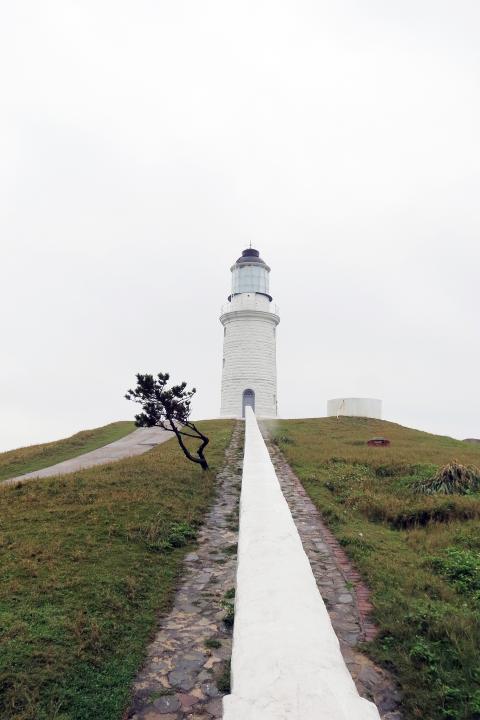The Tungchu Tao Lighthouse in Matsu is a national historic building, the first granite lighthouse built in Taiwan, which has survived the shifts of contemporary history.
The tower is located on Dongju, one of the islets of the Matsu archipelago about 25km off the coast of China.
It was constructed in 1872 during the Qing Dynasty, based on a commerce and navigation agreement signed by the Qing administration and Great Britain following China’s defeat in the Opium Wars.

Photo: CNA
The lighthouse was designated a grade two historic building by the Ministry of the Interior in 1988.
The Tungchu Tao Lighthouse is the only one built of stone that is open to visitors.
Lighthouse director Chang Wei-lun (張維倫) said that during the late Qing Dynasty, customs offices were largely staffed at senior levels by foreigners, mainly Britons.
As a result, a British company was responsible for the construction and design of the lighthouse, and a foreigner continued to serve as the director of the lighthouse until 1949, Chang said.
The most distinctive feature of the lighthouse grounds is a 30m-long windbreak wall connecting the lighthouse and an office annex.
Chang said that when oil lamps were used for illumination, lighthouse keepers would walk along the wall between the lighthouse and the office to prevent lamps from being blown out during strong winds.
Also preserved is a rainwater collection system on an upper tier of the lighthouse, which was an important source of fresh water in the remote area.
The Tungchu Tao Lighthouse, like other lighthouses around the nation, was managed by the Customs Administration under the Ministry of Finance until 2013, when it was transferred to the Maritime and Port Bureau under the Ministry of Transportation and Communications.

Trips for more than 100,000 international and domestic air travelers could be disrupted as China launches a military exercise around Taiwan today, Taiwan’s Civil Aviation Administration (CAA) said yesterday. The exercise could affect nearly 900 flights scheduled to enter the Taipei Flight Information Region (FIR) during the exercise window, it added. A notice issued by the Chinese Civil Aviation Administration showed there would be seven temporary zones around the Taiwan Strait which would be used for live-fire exercises, lasting from 8am to 6pm today. All aircraft are prohibited from entering during exercise, it says. Taipei FIR has 14 international air routes and

Taiwan lacks effective and cost-efficient armaments to intercept rockets, making the planned “T-Dome” interception system necessary, two experts said on Tuesday. The concerns were raised after China’s military fired two waves of rockets during live-fire drills around Taiwan on Tuesday, part of two-day exercises code-named “Justice Mission 2025.” The first wave involved 17 rockets launched at 9am from Pingtan in China’s Fujian Province, according to Lieutenant General Hsieh Jih-sheng (謝日升) of the Office of the Deputy Chief of the General Staff for Intelligence at the Ministry of National Defense. Those rockets landed 70 nautical miles (129.6km) northeast of Keelung without flying over Taiwan,

City buses in Taipei and New Taipei City, as well as the Taipei MRT, would on Saturday begin accepting QR code payments from five electronic payment providers, the Taipei Department of Transportation said yesterday. The new option would allow passengers to use the “transportation QR code” feature from EasyWallet, iPass Money, iCash Pay, Jkopay or PXPay Plus. Passengers should open their preferred electronic payment app, select the “transportation code” — not the regular payment code — unlock it, and scan the code at ticket readers or gates, General Planning Division Director-General Liu Kuo-chu (劉國著) said. People should move through the

The Ministry of National Defense (MND) today released images of the military tracking China’s People's Liberation Army (PLA) movements during the latest round of Chinese drills around Taiwan. The PLA began "Justice Mission 2025" drills today, carrying out live-fire drills, simulated strikes on land and maritime targets, and exercises to blockade the nation's main ports. The exercises are to continue tomorrow, with the PLA announcing sea and air space restrictions for five zones around Taiwan for 10 hours starting from 8:30am. The ministry today released images showing a Chinese J-16 fighter jet tracked by a F-16V Block 20 jet and the